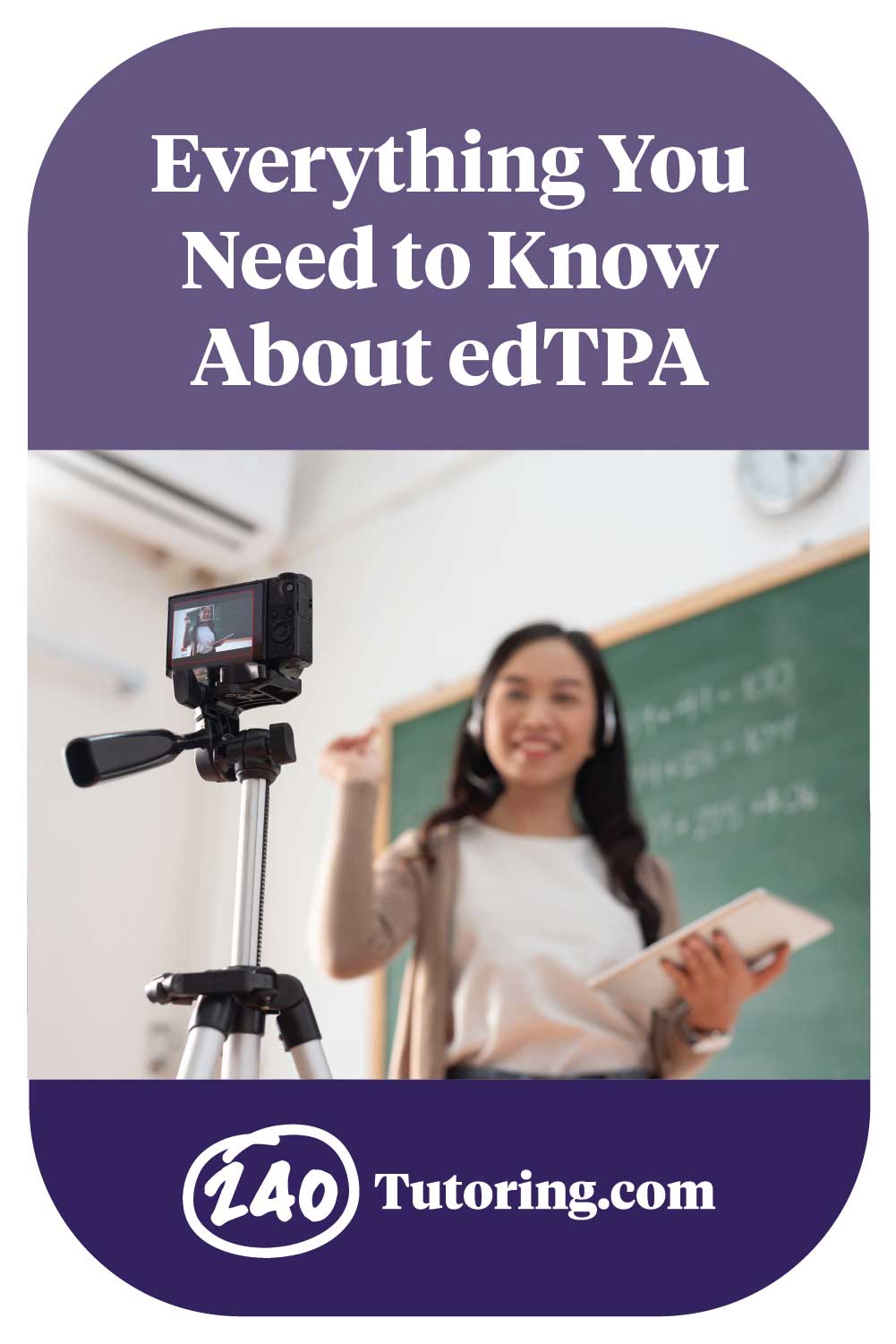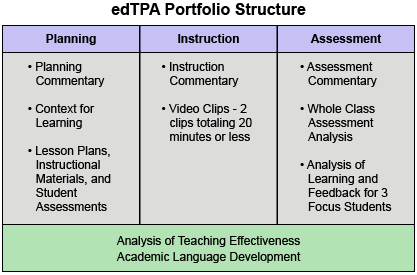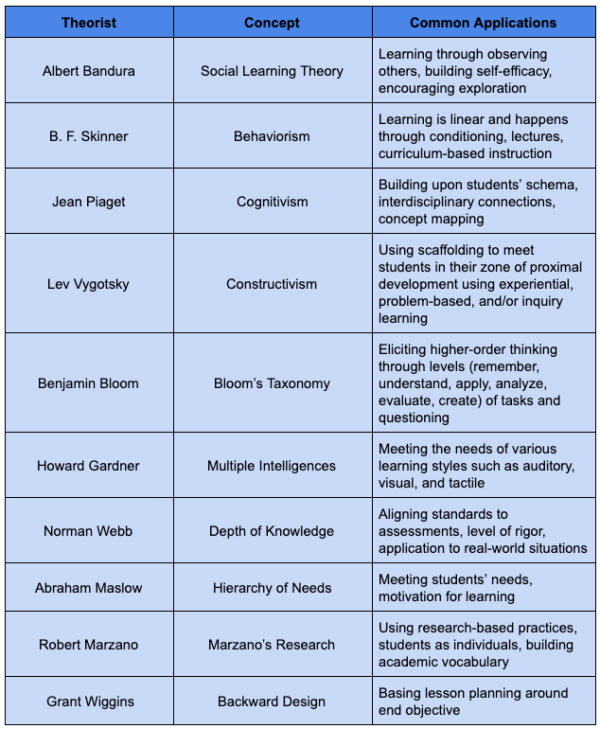Not sure what to study, or if you are going to pass? We can help!
I'm a teacher candidate at a university/college I'd like to transition to teaching I'm a current / former teacher I'm in leadership for K-12 or Higher Ed (EPP)Everything You Need to Know About edTPA
Working toward your dream of becoming a certified teacher? Depending on what state you want to teach in, you may have to pass the edTPA (the Educative Teacher Performance Assessment).

 If you are working toward becoming a certified teacher, you may be required to complete the performance-based edTPA (the Educative Teacher Performance Assessment). The edTPA assessment is currently used in some capacity by teacher preparation programs in several states across the U.S.
If you are working toward becoming a certified teacher, you may be required to complete the performance-based edTPA (the Educative Teacher Performance Assessment). The edTPA assessment is currently used in some capacity by teacher preparation programs in several states across the U.S.
Texas has been piloting the edTPA since 2019. The State Board for Educator Certification recently approved a Texas Education Agency recommendation to adopt its usage, and a final decision will go before the State Board of Education to approve or reject the new rule in June 2022. Under the ruling, Texas teaching candidates would take it or the PPR through 2023, depending on their EPP’s participation in the pilot.
The goal of the assessment is to make sure new teachers have the skills they need for day one readiness in the the classroom from the start of their teaching careers. The edTPA is a performance-based assessment designed to gauge a candidate’s ability to effectively teach a class of students.
This assessment is very different from the other certification exams you’ll pass to become a teacher. On certification exams, you show that you have the content knowledge needed to teach by answering questions and possibly writing essays. You will most likely have to take at least two exams– one on teaching methods and another on the subject you wish to teach.
With edTPA, you will demonstrate your ability to plan for, instruct, and assess your students, and provide evidence to support each decision made in the 3-5 days of recorded lessons.
What Do I Need to Know About edTPA?
The edTPA is broken into 3 tasks: planning, instruction, and assessment. Typically, each task has five rubrics provided to guide you and help explain how you’ll be scored. You will also be given a handbook specific to your certification area. You will submit written commentary and artifacts that include information about your Context for Learning (more on this later), lesson plans, video footage, and copies of lesson materials, assessments, and assessment results.

This process can appear to be overwhelming; however, these are some of the very things you WILL do as a teacher in your classroom. Planning, instructing and assessing are parts of teachers’ daily lives. Effective teachers should also reflect on their practice regularly.
While you won’t have to write out each step of the learning cycle as extensively in your daily teaching routine as you will for edTPA, (thank goodness!) consider it an opportunity to practice teaching an exemplary, standards-based lesson to a group of deserving students. Show what you know about being an effective educator as you meet your goal of stepping into your very own classroom.
How Am I Scored on edTPA?
Generally, each of the three edTPA tasks is broken into rubrics. Each of the 15 total rubrics has 5 scoring levels worth 1 point each, so you can earn between 1 and 5 points for each rubric. The highest possible score you can make on edTPA is 75.
Keep in mind, scoring a 3 on a rubric is evidence of a competent entry-level teacher.
Anything above a 3 is considered to exceed expectations for an entry-level teacher.
The edTPA itself does not have an official passing score. Each program or state sets its own, known as a “cut score.” The cut score ranges from 37 to 42. Check with your program to understand your cut score so you can set your goals accordingly while working through edTPA.
Your edTPA portfolio is evaluated by a scorer. Scorers are recruited, hired, trained, and monitored for quality scoring. All scorers are professionals from the field. Your scorer will be familiar with your content area and subject matter.
Preparing Yourself for the edTPA
Once you are registered in the official edTPA portfolio system, you will receive a specific handbook. While everyone does very similar tasks, each content area has its own details and guidance. For example, the project prompts and questions answered will vary between a general elementary education teacher and a special education teacher, but both will complete the same types of tasks.
Read through your handbook, taking special note of the Task Overview Chart at the beginning and Evidence Chart at the end. These charts help you understand the specific requirements of what you submit for your assessment. It is also important to know your edTPA submission dates and use them to plan backwards. Set yourself up for success by beginning with the end in mind! This will help guide your decisions when working through the tasks.
Remember: The handbook is very detailed and specific for a good reason. It lists exactly what you need to do.
Don’t worry! This guide will still help you understand what you will be doing for your edTPA process. In fact, your handbook will make a lot more sense after you keep reading.
Getting Started: Context for Learning
This is your opportunity to describe your teaching environment in detail for your scorers. The artifact you submit will include specific information about your school and classroom. It will also allow you to explain the demographics of your class, including special learning needs and accommodations. If applicable, this will be an opportunity to explain the school’s required curriculum and how it may affect your learning segment.
Getting Started: Scheduling
When you begin your student or clinical teaching experience, talk to your mentor teacher about edTPA. It is important that your mentor teacher understands you will need 3-5 days to film the learning cycle. Ideally, the days should be consecutive and not during an irregular schedule, like campus testing days. Your mentor teacher can help you pick the best days for filming.
You also want to make sure you’ve had enough time in the classroom to develop rapport with the students and establish classroom management skills. Your students should be comfortable with you and want to work hard for you! Let them know what you are trying to accomplish (you have education goals just like they do!) and why there will be filming in their classroom.
If possible, try filming a practice run with a different lesson so you and the students can get used to the camera. Also, schedule enough time after the learning cycle for edits and revisions to your portfolio. Plan ahead to save yourself from feeling rushed. You should feel confident that you are submitting your very best work!
So to sum up:
- Pick the best time for filming by coordinating with your mentor teacher
- Not too early – give yourself time to get to know your students (and vice-versa!)
- Not too late – give yourself enough time to feel confident about your submission without being rushed
Logistic Tip: Your program will provide forms to use to obtain written consent from anyone who appears in your video. Take care of this early enough that you can collect forms well before filming day and have the opportunity to work with your mentor teacher to make arrangements for any students who do not have consent to appear in the video.
Task 1: Planning
Overview
In Task 1, you are expected to plan the instruction and assessment for your learning segment.
Before you begin: Outline the key elements of your lesson.
- Learning Segment – 3-5 lessons aligned to both the central focus and student content standards
- Central Focus – the understanding your students will develop throughout your learning segment
- Student Content Standard – the national, state, or local learning standard on which your central focus is based
- Student Learning Objective – what you want your students to know and be able to do after your learning segment; this can change from lesson to lesson
You will submit:
- Context for Learning
- Learning Segment Lesson Plans
- Instructional Materials
- Assessments
- Planning Commentary
Your graders will use rubrics 1-5 (listed below) to evaluate your submissions for Task 1.
Remember, specifications about each of these submissions can be found on the Evidence Chart in your handbook!
Rubric 1: Planning for Content Understandings
Get ready to write the best lesson plans of your life! Consider this an opportunity to feel thoroughly prepared and work through how you want your lessons to go. What will you do each step of the way? What will your students be doing? Anyone reading your plans should be able to clearly picture each part of each lesson. Be detailed, but keep in mind that each lesson must be four pages or less in length. Scorers will not read additional pages.
Lesson Plan Template:
-
- Lesson focus or big idea
- State or national standard upon which your lesson is based
- Associated learning objectives
- Vocabulary
- Materials
- Lesson Procedure
- “Before” tasks (build background knowledge)
- “During” tasks (present new content, guided practice)
- “After” tasks (reflect, check for understanding)
- Opportunities for extension or integration with other subjects
- Assessments (both formal and informal)
Rubric 2 and 3: Knowledge of Students
This is where you show your depth of knowledge about your students and how they learn. Clearly plan what to do throughout the learning segment to meet all students’ individual needs. Think about how to utilize students’ strengths, consider their language development, and address their varied learning needs.
Make sure that any information you share about your students is evidence-based, and not stereotype-based. Show why you selected specific instructional approaches to best meet students’ needs through concrete examples, such as information about students’ backgrounds, resources, and experiences.
Make sure any claim you make is backed up by evidence!
For example, if you are building on a previously-taught concept in your learning segment, submit students’ writing or work samples that demonstrate their background knowledge. Just listing their background knowledge is not enough, you must explain the connection of prior knowledge to the current lesson and how it supports learning new concepts.
You will also make references to educational research and theory related to your learning segment. This should be more than simply stating your knowledge of the research or theory. Explain how it relates to your teaching and justify your choice of applying it to help your students meet their learning goals.
Rubric 4: Supporting Academic Language Development
This is your opportunity to think through the language of the discipline that students need to understand to be able to learn the content in this learning segment. Take special consideration of all English language levels in your classroom, including native speakers, speakers of various dialects, and English Language Learners.
The learning task should not be separate from the central focus and objectives, but rather integrated into the learning segment.
You will …
Identify a Language Function – Reference your edTPA handbook for a list of language functions within your content area. Choose one that all students will need to be successful throughout the learning segment.
Select a Learning Task – Pick a task from your learning segment that presents students with a chance to practice the chosen language function. Students need to do a combination of speaking, listening, reading, writing, or performing as part of this task.
Identify Additional Language Demands – Think through other language demands on the students involved in the language function and learning task, such as vocabulary, syntax, and/or discourse.
Once you’ve identified these language components of your learning segment, plan instructional supports to help students use that particular language in their classroom communication. These should be specific interventions and not just general instruction. For example, providing a sentence starter to help a student write an introductory paragraph would be considered an instructional support.
Rubric 5: Planning Assessments
This is where you plan how your students will demonstrate the knowledge they’ve gained from your learning segment. It will be exciting to see the impact the 3-5 days’ worth of lessons had on them! You are free to choose existing assessments, adapt existing assessments, or design your own. No matter what choice you make, confirm that the assessments align with your central focus, standards, and learning objectives.
You should use both formal and informal assessments in your learning segment. Provide students with opportunities to demonstrate understanding. Avoid assessments that focus solely on rote memorization. If you have students with IEPs or 504 plans, adjust the assessments in accordance with their plans.
This next part is essential! You must make sure the accommodations or modifications used are clearly documented, or your score will be automatically lower.
Remember the difference between accommodations and modifications. If the students need accommodations, the adjustments will only alter the way information is presented to students or how they demonstrate their knowledge, not any part of the central focus, standards, or learning objectives.
You may be expected to teach an already established curriculum. You can modify and teach an established curriculum and utilize teacher materials as long as the assessments and supplemental materials align with the edTPA tasks.
Task 2: Instruction
Overview
In Task 2, you will put your plans in action! You will video record yourself teaching students in a 3-5 day learning segment. For each of the rubrics in this task, submit video footage and written commentary that explains how the chosen video clips meet the rubric’s standards. Reference timestamps when describing components from the video clips in your commentary.
Before you begin: Read the commentary questions for the instructional video submission. You don’t want to end up with a video that doesn’t answer the handbook questions! You need to embed your instructional methodology into planning to make sure you hit the objectives. Also, make sure you comment on those specific examples.
You will submit:
- Video Clips
- Instruction Commentary
Rubric 6: Learning Environment
This is your opportunity to demonstrate evidence of the positive learning environment you have created for your students. Find video clips that exhibit respect and rapport in your class. Basically, you want evidence that shows you have positive feelings toward your students, and they have positive feelings toward you and each other.
There is nothing wrong with prompting students to respectfully communicate with each other while they are working together. In fact, specific verbal prompts you use, such as “listen to your partner share her ideas, then you can ask her questions about them”, can be cited in your commentary as evidence of using interventions to maintain a respectful class environment.
Show evidence of challenging your students as part of your positive learning environment. Ask students high-level questions and encourage them to explain their thinking. Allow students time to discuss what they’re learning with each other. Show that you have created an interactive learning environment that is well-managed, but is centered around student learning.
Video clips are the primary source for scoring this rubric. The commentary supports the video, but the scorer looks for recorded evidence. Remember, “engagement” is students “doing”, not just being attentive. Sitting and listening the whole time does not support the active nature of student learning. Students should be involved.
You should not be overly nervous about recording perfect students. They should be respectful, but also comfortable. If students sense the need for perfection, they can freeze and not be as engaged as you want them to be for the learning segments.
Rubric 7: Engaging Students
This is where you show students engaged in learning tasks using thinking, analysis, and judgment to learn what you have planned in your learning segment. Your video clip should feature students demonstrating the depth of their understanding of the content through probing questions from you or fellow students. Basic fact recall or skill practice that does not require high order thinking will not suffice.
You also need to make connections to prior academic learning and personal, cultural, and community assessments to provide context for the new learning in this clip. Prior academic learning can be a lesson taught the day before as part of the learning segment or something taught earlier but still connected to the current lesson. Personal, cultural, and community assets allow you to show that you know your students and can engage them by helping them make personal connections to the learning.
Basically, this is an assessment of how well you can activate prior knowledge in meaningful and authentic ways that connect directly to student learning.
The commentary on this rubric is intended to provide context for what you see in the video. Make sure not to describe events that do not appear in the video or conflict with what the video shows. These statements do not override what the video shows.
Rubric 8: Deepening Student Learning
This is your opportunity to show how you encourage students to think deeply about the content you’re teaching. Choose video clips that document yourself probing for responses at a variety of thinking levels. Be prepared to follow up elicited responses to extend students’ thinking. Ask students to explain their thoughts or elaborate by developing their ideas with detail. Students can also summarize or add on to what their classmates share.
Avoid yes/no questions, basic fact recall, and moving on from students’ responses without some kind of extension. Be sure to ask higher level questions instead of simple comprehension questions. You want to challenge students to find a deeper understanding of the content.
Rubric 9: Subject-Specific Pedagogy
This is your chance to show that you know your content and how to teach it. Select video clips that highlight how you guide your students to think in your subject area. Each handbook addresses specific pedagogy needs for your submission based on the grade level and subject you teach. Address interdisciplinary connections to the content. You should also cite research in your commentaries, demonstrating you can put theory into practice.
Rubric 10: Analyzing Teaching Effectiveness
This is your chance to show what you would do differently in your learning segment to optimize student learning of your central focus. The changes should focus more on instructional improvement and learning tasks than management issues, such as timing. As you note areas to improve, you should also highlight things that you did well.
Don’t hesitate to give yourself credit where credit is due!
Choose video clips that show student misunderstanding or a need for even more challenge. Once you’ve explained the changes you would make and why you think the changes would work, back your claims up by citing the educational theory or research that informed your decision.
Including citations is really important and can be the difference between an average scored rubric to a higher one. Keep in mind, the analysis must focus on the learning as it is mentioned in your commentary, otherwise, the theory cited will not improve your score.
Recommended changes should clearly address the learning needs of individual students and also show support of the whole class in the video clips. You would also be able to explain how your proposed changes related to your students individual needs.
Task 3: Assessment
Overview
Task 3 is all about assessment and using it effectively to help students continue to grow. Choose one assessment from your learning segment to thoroughly analyze based on rubrics 11-15.
Before you begin: Read through the assessment portion of your handbook to make sure you choose one that fits the criteria. You need to be able to provide specific feedback to students and complete your commentary based on the chosen assessment.
You will submit:
- Evidence of Learning (video or audio format)
- Observation Notes and Work Samples
- Evidence of Feedback
- Assessment Commentary
Rubric 11: Analyzing Student Learning
Choose one assessment that was administered to the whole class (individual, self, partner, and/or group assignments will not be accepted) during your learning segment to analyze. The assessment needs to fully show what each individual student knows and is able to do.
Check your handbook for the specific assessment requirements for your level and content area.
No matter what, your chosen assessment must correlate with the central focus and at least one learning objective from your learning segment. Use the same assessment to analyze both the whole class performance as well as one or more focus students. The analysis of the focus students’ work samples will be more thorough and detailed than the class analysis.
This is your opportunity to demonstrate your capacity to analyze students’ work to move them forward in their learning. While you always want your students to succeed, perfect performance on their assessment is not what your scorers are looking for – they want to see how well you can interpret and draw conclusions from student work. Reviewers are looking for you to make suggestions for logical next steps.
Keep in mind that the assessment you choose should give students the opportunity to show their thinking. Open-ended assessments, such as writing assignments and performance tasks, are preferable over simple recall assignments like questions with a one-word or multiple-choice selection response.
Analyze the chosen assessment based on the evaluation criteria you create. The evaluation criteria should indicate what you are looking for in your students’ work. Determine what you are assessing: quality, accuracy, originality, etc. Provide a graphic (a table or chart is recommended) that demonstrates student learning for your whole class. This graphic will help you determine your students’ patterns of learning, such as the most-understood areas, common misconceptions or errors, what may have caused those errors, etc.
For most subject areas, choose three focus students based on patterns discovered in your whole-class analysis. Your focus students should be at varying levels of performance. Check your handbook for the exact criteria to consider when choosing focus learners. Your analysis of the focus learners’ assessments should be very detailed. Be ready to provide evidence for all patterns of learning, misconceptions, and advanced understandings you cite.
Don’t worry about students not growing as much as you anticipated. The assessment analysis is important in showing how a teacher can take their students’ work and apply it to improve their planning/teaching. Candidates often focus on student scores and feel they failed if they do not see massive growth. But the commentary for Task 3 is all about analysis and reflection. Focus on articulating and synthesizing the data and your teaching and be thoughtful about what you learned from the assessments.
Rubrics 12 and 13: Feedback
This is your chance to show how you use feedback to help students understand both their strengths and areas of improvement based on the learning objective. Submit the actual feedback you gave your focus students based on their performance on the analyzed assessment. This feedback may be written on work samples, cited with a timestamp in video work samples, or given in a separate audio or video file.
Make sure the feedback you give is based on the central focus of your learning segment.
Specific comments such as “You made your argument clear by citing specific examples”, or “Make sure all your details support your main idea”, help the students understand their strong areas and what needs improvement. General comments such as “Nice work”, “Needs improvement”, or marking the percentage correct or incorrect will not help students understand their learning and performance. Be sure to provide students with actionable next steps in your feedback.
You should also explain how students can use your feedback to improve. Describe how you will confirm that students understand their feedback and what opportunities they have to apply it. Think through what will be most effective for your focus students – an opportunity to revise or a chance to try again in an upcoming lesson? What can you do as a teacher to support students in using your specific feedback to improve in the future that you didn’t do in the previous lesson?
Feedback is only effective if students are given a meaningful opportunity to apply it to future learning experiences! As a bonus, try to provide one focus student with a challenge or enrichment opportunity. This shows that you know how to remediate students who did not meet learning goals and that you can continue to push those who did.
If using written feedback to the student, be sure that your words are developmentally appropriate and can be understood by your student. For example, a lengthy written note for a kindergarten student would not be appropriate, as they are not fluent readers.
Rubric 14: Analyzing Students’ Academic Language Understanding and Use
You have already identified the language function, vocabulary, and additional language demands as part of Rubric 4 in Task 1. Now you can describe your students’ use of academic language and support your description with evidence from your Task 2 video clip, a separate video clip, or student work samples. Analyze your students’ use of academic language and how it reflects their understanding of the content.
Make sure your evidence shows students actually using language to demonstrate a connection to their progression in understanding the content. The evidence you submit should show students speaking or writing with academic language, not reciting vocabulary definitions. If your evidence shows that students did not fully master the language demands, make sure to include improvement strategies in your commentary.
Rubric 15: Use of Assessment to Inform Instruction
This is your opportunity to share the next steps you will take for your whole class, targeting your focus students and other students with particular learning needs based on your analysis of the learning segment. Your next steps should very closely reflect the data analyzed in Rubric 11 for Task 3.
Describe what you will do in following lessons to help students reach unmet learning objectives or expand on the new knowledge of students who demonstrated mastery. The next lessons should relate to the learning segment already taught and not move on to a different topic entirely. Small group intervention works well here!
You will also tie in research and theory you’ve learned to support your next steps. Common approaches and founders are listed below. Reference your handbook for guidelines on how to cite sources properly.
Candidates should also look at the research from their assessment course at the beginning of Task 1. Planning and Assessment are not separate, but intertwined.
Supporting Commentary with Research and Theory
Throughout your edTPA commentary, you will justify your instructional decisions with educational research and theory. You are not simply describing what you know about educational theory, but specifically explaining how this knowledge led you to the choices you made throughout your learning segment.
For example, you may reference cognitivism when justifying your choice to assign a concept map or Bloom’s taxonomy when explaining why you chose specific questions for students to answer.
State your references clearly – do not leave it to your scorer to make the connection for you!
Here are some common research theories to use where applicable:

edTPA Video Requirements
As mentioned above, try to schedule a trial run with the camera before your actual learning segment begins. This is a great opportunity to make sure everyone can be seen and heard clearly. Work the kinks out ahead of time! Try to wear a mic (or set it in the area where students are having discussions) to ensure quality sound in your video.
Check out your campus library to see what tech is available!
The library may be able to supply a mic and other helpful video recording equipment. This might include a tripod to fit your recording device (camera, tablet, etc.) or even a Swivl – a robotic mount for a recording device designed to track you so you do not have to worry about staying in the camera frame. Swivls are growing in popularity on school campuses. Don’t forget to see if your campus librarian or media specialist can help you out!
If you’ve already taken care of scheduling the best filming days possible, the next step is to make sure you’re not interrupted! While you can’t prevent every distraction that may arise in a classroom, do your best to minimize them. Give students a restroom and water break before filming begins. Set the expectations ahead of time to seek permission and exit appropriately if they do need to leave the classroom during filming.
Put a sign on the door to let others know you’re filming and avoid entering (or enter quietly) if possible. The edTPA scorers know that you are teaching in a real classroom with actual students, so don’t stress when life happens. You can always make a note in your commentary that students understand and follow the procedures of the classroom as evidence of your excellent classroom management skills!
edTPA Tips from the Experts
We asked current portfolio scorers to share their advice and insights about how to succeed in your edTPA journey. Here are the top tips they want all edTPA candidates to know:

Theresa, an edTPA Scorer says …
- Be sure to thoroughly read all instructions in the handbook.
- Make direct connections in your commentary. Do not leave it to the reader to assume anything. The connections have to be made by you to earn your score.
- When writing your learning segments, be specific about content connections, modifications, etc. Then be prepared to also write about it in your commentary. Even if it feels like you are repeating yourself, make sure it is in both places.

Raechel, an edTPA Scorer says …
- Provide direct explicit instruction whenever possible.
- Read the rubrics before beginning.
- Don’t get fancy and creative – this isn’t the time for over-the-top lessons. Scorers are looking for good fundamentals.

Dwayne, an edTPA Scorer says …
- Ensure lesson plans are organized and have achievable goals and objectives.
- Ensure lessons delivered are sequential and provide continuity.
- Ensure there is an opportunity for students to execute objectives within the lesson plans. For example, if the lesson objective is for students to compare and contrast historical figures, make sure students are given the opportunity to apply their learning and actually do a compare and contrast activity.

Kristen, an edTPA Scorer says …
- Read the handbook thoroughly and take notes before you begin.
- Get comfortable with the technology! Familiarize yourself with the platform, do a dry run of your filming, and make sure you are saving your commentary and material in the correct formats.
- Keep all student work and have a data collection mindset from the beginning.
Other edTPA scorers say …
- Don’t procrastinate! Stick with the suggested timelines.
- Answer each part of the prompts in full detail. If you write considerably less than the maximum number of pages allowed, then you probably haven’t fully answered the prompts
- Read the handbook and Making Good Choices documents. They have everything you need to know.
- Read the instructions carefully! There are many steps required, and the rubrics used for evaluation are very detailed and aligned with the instructions. Answer all parts of a question thoroughly. If a question asks for research, cite from sources and not just what you remember from class. Spend the most time on Task 1.
- Use specific examples when you answer the long-answer questions. The more specific you are, the better your chances of getting a higher score.
- The videos are incredibly important, and the written answers in the video section are only used for context. Most of the scoring in that section comes from the actual videos, so make them count.
- All three tasks are connected and should show the full journey of the 3-5 lessons. Nothing should feel like it was done in isolation of the other components, or like it was “thrown in.” Don’t let the fact that there are so many parts overwhelm you and cause you to lose sight of the bigger picture!
So, now you know what to expect and how to earn a passing score when it’s time to tackle the edTPA. Give yourself plenty of time to prepare, keep these great tips and reminders in your back pocket, and you should have no problem being successful with your assessment and moving on to the next step in your teaching career!
Looking for help passing your teacher certification exams? We offer comprehensive study guides for TExES, Praxis, FTCE and more!

